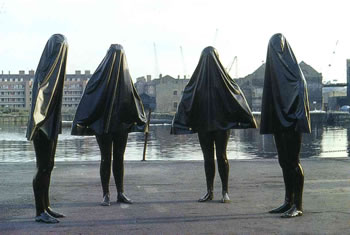“CIRCLE” 1970

POPULAR PRESS Someone said it was art. And in a way they were right. It was a perfect exercise in the art of human reaction. The four 'nudes' appeared quite suddenly in Paternoster Square, in the shadow of St Paul's Cathedral. Dummies, of course. But shrouded in cloaks. Well, into yesterday's hot sunshine at lunchtime came the office crowds ... to gape ... to giggle ... to satisfy their curiosity. Some dared to sneak a peek under the cloaks, but many were too embarrassed. Others preferred to leave the illusion intact. But no-one passed without a second glance.
'Temp' Meg Carr, 26, from Blackheath, London, said: 'The idea is to make people want to know what's underneath, I suppose. I mean, no-one would take a second look at them if they were ordinary, unclothed dummies, would they?'
Daily Mail, Wednesday July 8 1970
ART PRESS The most successful and enigmatic of these early works is the outdoor 'Circle' 1970; four female figures, draped in covers which reach over their heads and down to their thighs, stand in a semi-circle. The anonymity here is not only imposing but terrifying; that Garrard should appropriate the devices of the horror story - concealment, exclusion, prohibition - is a clue to the darkening sense of absence and powerlessness the work seeks to convey. Just as reading against the grain in children's fiction produces a series of dispiriting sexual stereotypes of patriarchal violence, these figures belie their own fictional 'innocence'. Their very self-effacement gives them the appearance of Victim, of Other, of figures from the realm of the untouchable. In these works Garrard is speaking through the body by denying its physical existence; these hooded, featureless women are bodiless because they have no real female models to call upon.
John Roberts, 'Between Ourselves', Ikon Gallery, Birmingham, 1984
ARTIST'S NOTES 'Circle', conceived as a repeat unit multiple of four or more figures, always included one gap to indicate to the spectator that they could enter inside or link up the circle. This combination of live and static human presences was in part a desire for unity in response to the increasing levels of state violence which met student protests in Europe and America at that time. The piece caused much comment when in a strange coincidence four students were shot and killed at Kent State University while it was being shown at the Serpentine Gallery, and it was removed from the Dublin Gallery window where people saw it as a direct reference to the 'troubles'. The mini skirted shrouds were a deliberate subversion of the then current obsession with women's legs, exemplified in Claes Oldenburg's cooling tower/women's knees multiples. Before my interview for the course at Chelsea I was advised that if I wanted a real chance I should wear a mini-skirt not trousers and shouldn't admit to having a regular boyfriend. I complied and gained a place, but the mood of this piece registers the personal cost of these negative experiences by powerfully visualising my own sense of being seen as 'a sex object' rather than as a sculptor. The Daily Mail newspaper published a photo of 'Circle' with a mini-skirted passer by bending over in front of the camera to lift up their coverings. I replied by repeat copying the mini skirted woman, collaging them to form a circle lifting their own skirts, and suggesting that they print this instead. The paper sent a letter of apology for taking the piece so lightly, and surprisingly, of encouragement to do more work.
Rose Garrard 1994
SITES
'First Show' Serpentine Gallery London 'Summer Summary' Alwin Gallery London
'Triangle' TUC Headquarters Congress House London 'London Now' Messenhallen West Berlin
'Spring in the Air' Hugh Lane Municipal Art Gallery Dublin
COMPONENTS
Multiple of life size figure repeat unit in resin and fibreglass with PVC covers
COLLECTION
First four units sold by the Alwin Gallery London to anonymous Swiss collector.